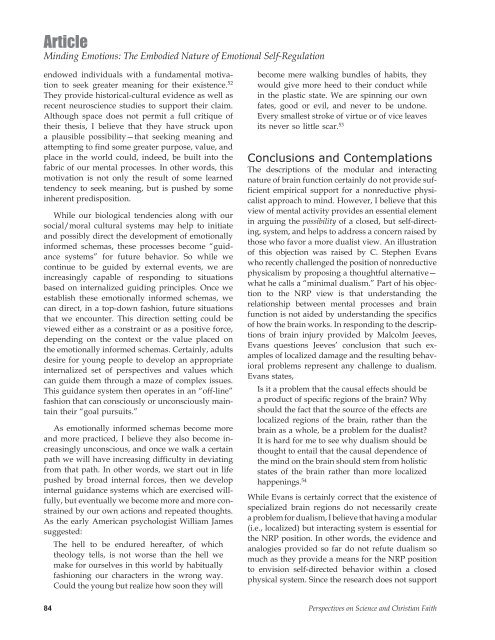ASA BLOGS - Start
ASA BLOGS - Start
ASA BLOGS - Start
You also want an ePaper? Increase the reach of your titles
YUMPU automatically turns print PDFs into web optimized ePapers that Google loves.
Article<br />
Minding Emotions: The Embodied Nature of Emotional Self-Regulation<br />
endowed individuals with a fundamental motivation<br />
to seek greater meaning for their existence. 52<br />
They provide historical-cultural evidence as well as<br />
recent neuroscience studies to support their claim.<br />
Although space does not permit a full critique of<br />
their thesis, I believe that they have struck upon<br />
a plausible possibility—that seeking meaning and<br />
attempting to find some greater purpose, value, and<br />
place in the world could, indeed, be built into the<br />
fabric of our mental processes. In other words, this<br />
motivation is not only the result of some learned<br />
tendency to seek meaning, but is pushed by some<br />
inherent predisposition.<br />
While our biological tendencies along with our<br />
social/moral cultural systems may help to initiate<br />
and possibly direct the development of emotionally<br />
informed schemas, these processes become “guidance<br />
systems” for future behavior. So while we<br />
continue to be guided by external events, we are<br />
increasingly capable of responding to situations<br />
based on internalized guiding principles. Once we<br />
establish these emotionally informed schemas, we<br />
can direct, in a top-down fashion, future situations<br />
that we encounter. This direction setting could be<br />
viewed either as a constraint or as a positive force,<br />
depending on the context or the value placed on<br />
the emotionally informed schemas. Certainly, adults<br />
desire for young people to develop an appropriate<br />
internalized set of perspectives and values which<br />
can guide them through a maze of complex issues.<br />
This guidance system then operates in an “off-line”<br />
fashion that can consciously or unconsciously maintain<br />
their “goal pursuits.”<br />
As emotionally informed schemas become more<br />
and more practiced, I believe they also become increasingly<br />
unconscious, and once we walk a certain<br />
path we will have increasing difficulty in deviating<br />
from that path. In other words, we start out in life<br />
pushed by broad internal forces, then we develop<br />
internal guidance systems which are exercised willfully,<br />
but eventually we become more and more constrained<br />
by our own actions and repeated thoughts.<br />
As the early American psychologist William James<br />
suggested:<br />
The hell to be endured hereafter, of which<br />
theology tells, is not worse than the hell we<br />
make for ourselves in this world by habitually<br />
fashioning our characters in the wrong way.<br />
Could the young but realize how soon they will<br />
become mere walking bundles of habits, they<br />
would give more heed to their conduct while<br />
in the plastic state. We are spinning our own<br />
fates, good or evil, and never to be undone.<br />
Every smallest stroke of virtue or of vice leaves<br />
its never so little scar. 53<br />
Conclusions and Contemplations<br />
The descriptions of the modular and interacting<br />
nature of brain function certainly do not provide sufficient<br />
empirical support for a nonreductive physicalist<br />
approach to mind. However, I believe that this<br />
view of mental activity provides an essential element<br />
in arguing the possibility of a closed, but self-directing,<br />
system, and helps to address a concern raised by<br />
those who favor a more dualist view. An illustration<br />
of this objection was raised by C. Stephen Evans<br />
who recently challenged the position of nonreductive<br />
physicalism by proposing a thoughtful alternative—<br />
what he calls a “minimal dualism.” Part of his objection<br />
to the NRP view is that understanding the<br />
relationship between mental processes and brain<br />
function is not aided by understanding the specifics<br />
of how the brain works. In responding to the descriptions<br />
of brain injury provided by Malcolm Jeeves,<br />
Evans questions Jeeves’ conclusion that such examples<br />
of localized damage and the resulting behavioral<br />
problems represent any challenge to dualism.<br />
Evans states,<br />
Is it a problem that the causal effects should be<br />
a product of specific regions of the brain? Why<br />
should the fact that the source of the effects are<br />
localized regions of the brain, rather than the<br />
brain as a whole, be a problem for the dualist?<br />
It is hard for me to see why dualism should be<br />
thought to entail that the causal dependence of<br />
the mind on the brain should stem from holistic<br />
states of the brain rather than more localized<br />
happenings. 54<br />
While Evans is certainly correct that the existence of<br />
specialized brain regions do not necessarily create<br />
a problem for dualism, I believe that having a modular<br />
(i.e., localized) but interacting system is essential for<br />
the NRP position. In other words, the evidence and<br />
analogies provided so far do not refute dualism so<br />
much as they provide a means for the NRP position<br />
to envision self-directed behavior within a closed<br />
physical system. Since the research does not support<br />
84 Perspectives on Science and Christian Faith




